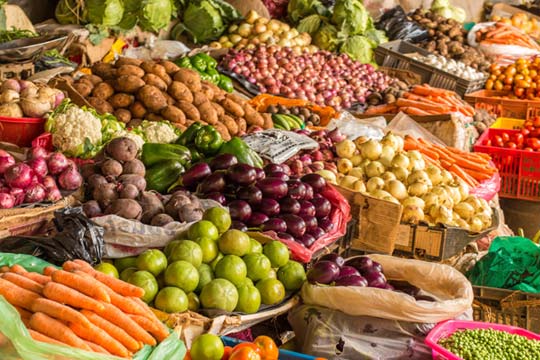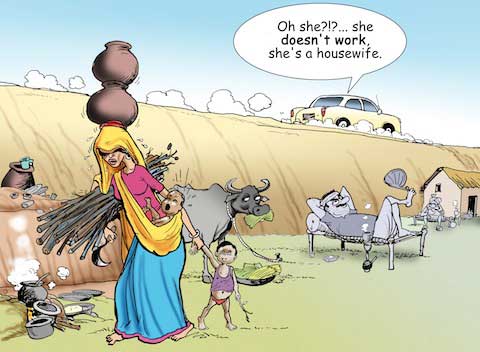Biodiversity has been used by humans since time immemorial as food, medicines, for industrial and spiritual purposes.
Biodiversity comprises the variability of living organisms that includes terrestrial, marine and other aquatic species, their habitats and the ecosystem they live on. However, biodiversity is under threat among others from environmental degradation, pollution, war and industrial and chemical agriculture. Many species have already been lost. We are witnessing land degradation, loss of biodiversity, deforestation, ocean acidification, carbon emissions and alteration in biogeochemical cycles. The Stockholm Resilience Centre warns that the «Earth`s System» as a whole is being destabilized to a new state of imbalance as a result of such activities. A well-known scientist had the following to say about the loss of species «Humanity can bring upon itself consequences similar to those expected from a nuclear winter when biodiversity disappears.»
Agro-biodiversity and Women
Agro-biodiversity is the diversity of crops and associated trees, animals, microbes and other species that add to agricultural production. Food production based on diversity can contribute to increased production and more resilience to withstand local climatic pressures. Furthermore, diversity-based agriculture adds to better nutrition and livelihood to families.
Agrodiversity forms the basic foundation of agriculture. When diverse crops and varieties are grown together, pests and diseases cause less damage. It is a cost-effective way for farmers to rely on diversity. Traditional knowledge and culture of farmers is often associated to local biodiversity and its use. Local varieties are sturdier in withstanding vagaries of climate. A biodiverse agriculture, therefore can be vital to soil health, production of nutritious food and also make room for diverse pollinators that are important for food production.
Women are largely responsible for the use and management of resources, and play multiple roles towards achieving food security. Women save and sow seeds. Before sowing they conduct experiments with the seeds collected from previous years and plant the ones that fare well. Through a keen sense of observation they have developed knowledge of different varieties suited to local ecology. They have also cultivated and selected new varieties as a result. Further they are involved in weeding, harvesting, threshing, processing of food, transportation and taking the produce to the markets. Men also play distinct roles in their work in agriculture, livestock raising, fishing and collection of forest products, and they clear, plough the field and participate in other agricultural tasks.
Women are also in charge of home-gardens that are situated close to their homes. Vegetables are grown on roof tops and walls and are eaten immediately. They also cultivate indigenous vegetables and greens that cater to their nutritional and culinary habits. Edible spinach and other greens that grow along with crops also give additional nutrition. Wild species also form part of their diet. In this way women cater to food security and nutrition to their families.
Women’s labor in agriculture
Scarcity of land, resource base for independent farming and lack of capital purchase makes it difficult for women to work independently. Due to industrialization in 19th century Europe women became dependent on the husband. More and more products are produced for the market, so also agricultural products. Women`s work becomes invisible, it is not in the National statistics. Furthermore there is systematic sexual discrimination when it comes to agricultural delivery systems. Previously farming work was complementary, women had their role and so did men. A study conducted recently in Tanzania confirms this. In sub-Saharan Africa, women contribute between 60 – 80% of labor in producing food for household production and for sale. There are about 500 million family farms today who produce a large proportion of food in the world.
Modern Food Systems
The large-scale food production system adopted since the 1950`s has been based on use of fossil fuels, fertilizers and pesticides. Modern agricultural production and methods of land- use have contributed to carbon emissions. In this type of food a large amount of energy go to production of fertilizers and pesticides. Right from the production of corn to meat to an ever-increasing aquaculture is responsible for at least 18% of carbon dioxide emissions, polluted soils, and reduction in water table. Veterinary medicines, such as antibiotics and hormones, and waste created from meat production and cultivation of monocultures has further depleted and polluted valuable water resources, biodiversity, and top soil. It is a wake-up call according to scientists and these matters need to be addressed urgently.
From the start the features of modern industrial mode of agriculture lay in mechanization, efficiency, speed, uniformity and standardization, the success of which is only calculated through profits acquired by agribusinesses. Oliver de Schutter who was the United Nation`s Special Rapporteur urged for an alternative system which must be addressed at the local, national and international levels. The change should focus on food diversity, culturally acceptable food to communities, supporting small holders, protecting soil and water resources. In other words, Food Sovereignty must be given priority. Many activities need to go hand in hand with a bottom up approach at different levels: village level, regional level, cities and municipalities. He articulates that the World Trade Organisation must not interfere with developing countries that are working towards local food policies and investing in small holder agriculture. Simultaneously, rich countries should also embark upon improving their own food security.
We now know that 60 – 80% of the women in the world are responsible for producing food. Many of the small holders are women. Women as we know have no formal rights to land in many parts of the world. Land and capital is administered often by men and women`s contribution is often stopped due to a male oriented solutions or cultural values. Women`s empowerment is the key to food security, health and family welfare.
Women and the Right to Food
The Universal declaration of human rights was adopted by the United Nations in 1948. It laid the foundation for freedom, justice and peace in the world. Article 25 states that all humans have the right to food. This right embodies the right to live in dignity, free from hunger, food insecurity and malnutrition. 65 years later this goal is far from reality, and we see that a large population of the world`s children, women and men are suffering from food insecurity. The Food and Agricultural Organisation estimates that 870 million people in the world are undernourished. The World Food Summit of 1996 and later the United Millennium Declaration undertook to halve the undernourished by 2015.
In 2010 several human rights experts met at Kuala Lampur and worked on guidelines towards an Ecological Agricultural policy with a human rights approach. They argued that the modern agricultural food system posed threats to economic, social and cultural rights of people. Commercialisaiton, monopolization and market concentration, genetically altered seeds, Intellectual Property Rights, chemical inputs and agrofuel productions were identified a risks to food security.
In her speech on 16. Oct. 2014 the present UN Special Rapporteur Hilal Elver said that there are 500 million family farmers in the world. Women play an important role in food security and nutrition for their families, yet they are bogged down by poverty, malnutrition and unpaid carework that they render their families and society. Therefore women`s rights must be central when it comes to Right to Food Policy.
Farmers meet different circumstances, and when it comes to cultivation of food their knowledge and expertise is decisive. For example, the Dodoma district in Tanzania is very dry and rainfall is unpredictable. To tackle this problem farmers sow three types of Sorghum seeds, thereby ensuring a crop and nutritious food. We know today that Sorghum is highly nutritious.
During famine in the 1980`s in Ethiopia peasant farmers buried their seeds in a clay pot, sealed it and buried it before they moved on. In a survey among the agropastoral peoples of S. Sudan showed that their granaries were empty. But the following year, it was found that the Sorghum fields were filled with traditional varieties. When asked the women said that they did not dare tell the scientists. If their husbands knew that women had buried their seeds they would have forced the women to cook them. From experience women relied on their traditional seeds rather than the Government supplying exotic seeds that fairs poorly after such disasters.
We also know that women are often the worst affected whether it is war or environmental destruction. During war, production and access to food becomes difficult. Women`s problems accelerate as they are not able to take care of their children and their families. The paradigm of economic growth, technology and consumption needs a second thought. It is vital that we start to unwind the current system of food production with feminine principles of production- that which halts environmental destruction, pollution, war, blind reliance on technological solutions and enhances biodiversity.
People and environment, hereunder human rights to food, must be high on the agenda. Food is a basic need and it`s production must be reorganized to ensure enough and nutritious food for all. We are already seeing initiatives towards sustainable evelopment from villages to cities all over the world. These activities is one step towards a just world where food security and health security is priority. Women’s potential as promoters of peace and sustainable development of communities is to be recognized. While finding solutions it is important to secure women’s empowerment and agro-independence during peace times.
Bhanumathi Natarajan
bhanu.natarajan (at) gmail.com
WILPF Norway
13th April 2015



